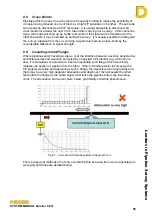
Leaders in Pipelin
e Survey Systems
C
C
C
-
-
-
S
S
S
C
C
C
A
A
A
N
N
N
2
2
2
0
0
0
1
1
1
0
0
0
SYSTEM MANUAL Version 6.03i
54
8. INTERFERENCE AND FIELD DISTORTION
8.1. The C-SCAN Signal
The C-SCAN System operates with a ‘clean’ sine wave signal of 937.5Hz. The band width
of the filters on the Detector is less than 20Hz. The frequency used and the small band
width have been selected to minimise interference from commonly occurring frequencies
while maximising the distance that the signal can travel and still provide useful data (3-6
miles on a reasonably well protected pipeline).
8.2. Ground Lead Interference
When the signal is injected onto the pipeline, the
Ground Lead
coming from the Signal
Generator will emit a signal similar to that of the pipeline at the signal injection point, and
the signal will divide where it enters the pipeline, with roughly half of the signal going in
each direction. There will therefore be considerable mutual interference of radiating fields
around the signal input point. In order to minimise the length of pipe over which this
interference is likely to prevent useful readings being taken, it is essential that the cables
are laid out perpendicular (at 90
º
) to the pipeline axis, and the ground point is as far away
as possible. In normal circumstances, a length of pipe 30-50ft (depending on depth of
pipeline) either side of the signal injection point cannot be surveyed and must be covered
in the next ‘leg’ when the Signal Generator has been moved to its next location.
8.3. Other Signals Carried by the Pipeline
The instrument is not affected by any residual ‘ripple’ in the rectified current used in
standard cathodic protection systems, provided it is within certain limits (see 4.6, on page
23).
The C-SCAN signal will be significantly distorted if a ‘Pearson’ type survey is carried out
on any section of the same pipeline at the same time as a C-SCAN survey.
Some forms of military signals using powerful transmitters which are located near to a
pipeline, can result in the pipeline acting as an antenna and re-radiating a signal which
may overlap with the C-SCAN signal. If the existence of such interference is suspected,
the operator should turn off the Signal Generator and check whether a signal can still be
detected on the pipeline. If the ‘external’ signal appears to be constant, the true C-SCAN
signal will be arrived at by subtracting the value of the ‘external’ signal.
Overhead power lines of normal height will not normally affect the readings. The
instrument may pick up transient signals within its frequency range which arise in a
random fashion from e.g. telephone lines laid close to the pipeline, but these will usually
be eliminated by the signal averaging system.
8.4. Buried Metal Structures
Buried metal structures which are relatively large (e.g. other pipelines) and pass close to
or lie in the same trench as the pipeline under survey, can sometimes pick up the applied
signal and re-radiate it. This can occur through inductance or through signal current
escaping from a fault in the wrap on one pipeline and transferring to the other. This is
particularly likely to occur if the Signal Generator
Earth Spike
has been placed close to,
say, an unwrapped iron water pipe which also crosses the pipe being surveyed at some
point. The operator will usually recognise the anomalous readings produced in this
situation and must repeat the survey with the Signal Generator at a different location.






























